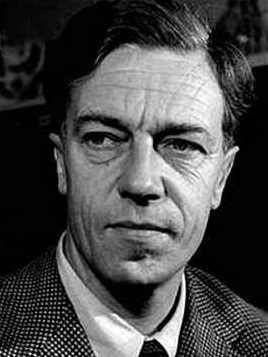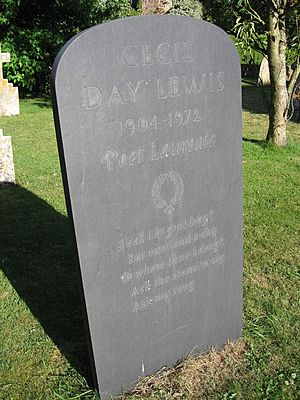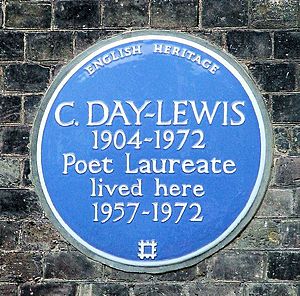Cecil Day-Lewis facts for kids
Quick facts for kids
Cecil Day-Lewis
|
|
|---|---|
 |
|
| Poet Laureate of the United Kingdom | |
| In office 2 January 1968 – 22 May 1972 |
|
| Monarch | Elizabeth II |
| Preceded by | John Masefield |
| Succeeded by | John Betjeman |
| Personal details | |
| Born | 27 April 1904 Ballintubbert, County Laois, Ireland |
| Died | 22 May 1972 (aged 68) Monken Hadley, Greater London, England |
| Resting place | St Michael's Church, Stinsford, Dorset, England |
| Nationality | British, Irish |
| Spouses |
Constance Mary King
(m. 1928; div. 1951) |
| Children | 4, including Tamasin and Daniel |
| Alma mater | Wadham College, Oxford |
| Occupation | Poet, novelist |
Cecil Day-Lewis (born April 27, 1904 – died May 22, 1972) was an important Irish-born British poet. He was named the Poet Laureate of the United Kingdom in 1968, a special role given to a poet by the British monarch, and held it until he passed away in 1972. He was also known for writing exciting mystery stories using the pen name Nicholas Blake.
During World War II, Day-Lewis worked for the British government. He helped with publications in the Ministry of Information. He also served in the British Home Guard in Musbury, which was a defense organization for local areas. Cecil Day-Lewis is the father of the famous actor Sir Daniel Day-Lewis and the documentary filmmaker and chef Tamasin Day-Lewis.
Contents
Early Life and Education
Cecil Day-Lewis was born in 1904 in Ballintubbert, Ireland. His father, Frank Day-Lewis, was a church rector. His mother, Kathleen Blake, passed away when Cecil was only two years old. After her death, Cecil was raised in London by his father and an aunt. He often spent summer holidays with relatives in County Wexford.
He attended Sherborne School and then went to Wadham College, Oxford. At Oxford, he became friends with other writers, including W. H. Auden. He even helped Auden edit a poetry collection called Oxford Poetry 1927. His very first book of poems, Beechen Vigil, was published in 1925.
Family Life and Career
In 1928, Day-Lewis married Constance Mary King. He worked as a schoolteacher at several schools, including Larchfield School in Scotland. Later, in 1951, his first marriage ended. He then married actress Jill Balcon.
During World War II, his poetry style changed. He started writing in a more traditional way, moving away from the style of his friend Auden. Many critics believe his poetry became even stronger in his book Word Over All (1943). After the war, he became a director and editor at a publishing company called Chatto & Windus.
Cecil Day-Lewis was a lecturer at Cambridge University in 1946. He published his lectures in a book called The Poetic Image. He was honored as a Commander of the Most Excellent Order of the British Empire (CBE) in 1950. This is a high honor in the UK. He also taught poetry at Oxford, where he was a Professor of Poetry from 1951 to 1956. From 1962 to 1963, he was a visiting professor at Harvard University in the United States.
In 1968, he was chosen as the Poet Laureate, following John Masefield. This meant he was the official poet of the United Kingdom. He held this important role until his death.
Day-Lewis was involved in many literary groups. He was chairman of the Arts Council Literature Panel and vice-president of the Royal Society of Literature. He was also a Professor of Rhetoric at Gresham College in London.
Cecil Day-Lewis passed away on May 22, 1972, at the age of 68. He was staying at the home of his friends, Kingsley Amis and Elizabeth Jane Howard, in Hertfordshire. He was a big fan of the writer Thomas Hardy. Because of this, he chose to be buried near Hardy's grave at St Michael's Church in Stinsford, Dorset.
Cecil Day-Lewis had four children. His sons with Constance Mary King were Sean Day-Lewis, a TV critic, and Nicholas Day-Lewis, an engineer. With Jill Balcon, he had Tamasin Day-Lewis, a chef, and Daniel Day-Lewis, the famous actor. Sean Day-Lewis later wrote a book about his father's life. Daniel Day-Lewis later gave his father's collection of poems to the Bodleian Library.
Writing as Nicholas Blake
In 1935, Cecil Day-Lewis decided to write detective novels to earn more money. He used the pen name Nicholas Blake for these books. His first mystery novel was A Question of Proof. In this book, he introduced a detective character named Nigel Strangeways. Nigel is an amateur investigator who can access official crime investigations because his uncle works at Scotland Yard.
Day-Lewis wrote 19 more crime novels as Nicholas Blake. In the first Nigel Strangeways book, the detective was inspired by W. H. Auden. However, Day-Lewis later made the character more serious and less over-the-top. By the mid-1930s, he was able to make a living just from his writing. Some of the Blake novels, like A Tangled Web and The Deadly Joker, do not feature Nigel Strangeways.
One of his novels, Minute for Murder, is set during World War II and reflects his experiences working for the Ministry of Information. Another book, Head of a Traveller, features a poet who is struggling with writer's block. People have wondered if this character was based on Day-Lewis himself or someone he knew.
Political Ideas
When he was younger, during the difficult time of the Great Depression, Day-Lewis was interested in communist ideas. He was a member of the Communist Party of Great Britain for a few years, from 1935 to 1938. His early poems often focused on social issues. In 1937, he edited a book called The Mind in Chains: Socialism and the Cultural Revolution. In this book, he supported a movement against a "Capitalism that has no further use for culture." He believed that knowledge and progress should benefit everyone, not just a few.
However, after the late 1930s, when there were many difficult events in the Soviet Union under Josef Stalin, Day-Lewis slowly changed his mind about communism. In his autobiography, The Buried Day (1960), he explained that he no longer held those views. His detective novel, The Sad Variety (1964), even shows a critical view of strict communist ideas and the actions of Soviet agents.
Selected Works
Poetry Books
- Transitional Poem (1929)
- From Feathers to Iron (1931)
- Collected Poems 1929–1933 (1935)
- A Time to Dance and Other Poems (1935)
- Overtures to Death (1938)
- Short Is the Time (1945)
- Selected Poems (1951)
- Collected Poems (1954)
- Pegasus and Other Poems (1957)
- The Gate, and Other Poems (1962)
- The Whispering Roots and Other Poems (1970)
- The Complete Poems of C. Day-Lewis (1992)
Essays and Non-fiction
- A Hope for Poetry (1934)
- Poetry for You (1944)
- The Poetic Image (1947)
- The Buried Day (Autobiography)
Translations
- Virgil's Georgics (1940)
- Paul Valéry's Le Cimetière Marin (1946)
- Virgil's Aeneid (1952)
- Virgil's Eclogues (1963)
Novels for Adults
- The Friendly Tree (1936)
- Starting Point (1937)
- Child of Misfortune (1939)
Novels for Children
- Dick Willoughby (1933)
- The Otterbury Incident (1948)
Nigel Strangeways Detective Novels
- A Question of Proof (1935)
- Thou Shell of Death (1936)
- There's Trouble Brewing (1937)
- The Beast Must Die (1938)
- The Smiler with the Knife (1939)
- Malice in Wonderland (1940)
- The Case of the Abominable Snowman (1941)
- Minute for Murder (1947)
- Head of a Traveller (1949)
- The Dreadful Hollow (1953)
- The Whisper in the Gloom (1954)
- End of Chapter (1957)
- The Widow's Cruise (1959)
- The Worm of Death (1961)
- The Sad Variety (1964)
- The Morning after Death (1966)
Other Detective Novels
- A Tangled Web (1956)
- A Penknife in My Heart (1958)
- The Deadly Joker (1963)
- The Private Wound (1968)
See also
 In Spanish: Cecil Day-Lewis para niños
In Spanish: Cecil Day-Lewis para niños
- List of Gresham Professors of Rhetoric



